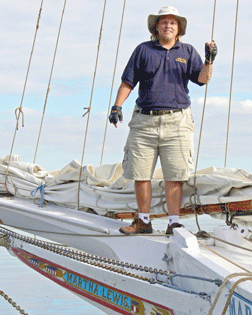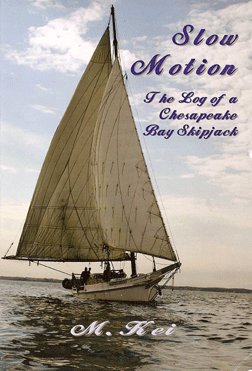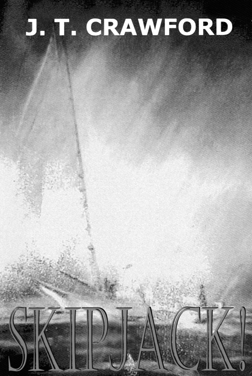
|
Volume 16, Issue 41 - October 9 - October 15, 2008
|
|
Columns |
For the Love of Skipjacks
Two Marylanders sail the grand old boats into literary waters
reviews by Dotty Holcomb Doherty and Sonia Linebaugh
Sails taut and spray flying, sailing vessels have plowed through time and our imaginations. With every adventure came a sailor’s story. On the Chesapeake, the broad-beamed skipjack has inspired many tales, from the work of dredging oysters to the watermen themselves. Though diminished now to a handful, this Chesapeake fleet still commands interest.
As sailors converge on Annapolis this week for the U.S. Sailboat Show, Bay Weekly celebrates the skipjack by reviewing two books. In one — Jerry Crawford’s Skipjack! — the boat is backdrop to a story journeying through history. In the other, M. Kei’s Slow Motion, The Log of a Chesapeake Bay Skipjack, short poems reveal nuances of daily life on a skipjack.
–DHD
Slow Motion, The Log of a Chesapeake Bay Skipjack
M. Kei wrote the poems for Slow Motion, The Log of a Chesapeake Bay Skipjack while crewing aboard the Martha Lewis on two autumn trips in 2007. After his short introduction on skipjacks, we sail with him from Havre de Grace to the Deal Island Skipjack Race, stopping for the night in Annapolis’s Ego Alley. The next — to Crisfield for the Watermen’s Festival — recalls the days when scores of skipjacks plied the waters of the Bay, when oystering still earned a paycheck and a life.
Each voyage is briefly introduced in prose, but Kei primarily tells his tale in verse. His favorite style of poem is the Japanese five-line tanka (pronounced tonka).
“When you are writing prose,” says Kei, “you could just keep writing forever and wander away from what really matters. With tanka, you are forced to distill the moment.” Kei’s inspiration to study Asian culture and poetry came from his high school Japanese exchange student. He began writing tanka in 2000.
“Tanka is the oldest Japanese form,” Kei says. “It is basically the mother of all the poetic forms in Japan. Haiku is a derivative. The tanka has been around for about 1,400 years. By contrast, haiku is only about 400 years old.”
In his poems, Kei captures the briefest moments — often overlooked or dismissed as ordinary — to take us on a sensory voyage, immersing us in the smells, sights and feel of sailing a skipjack.
rolling swells
spray breaking every
tenth wave
the cries of seagulls
scatter around us
–Off Tilghman Island
The brevity of tanka and haiku, Kei says, give us “dreaming room” to feel the sensations suggested by the poem.
starbow —
the Milky Way
horizon to horizon
–Wingate
Kei depicts scenes that match our life moments:
seaweed
wrapped around
a crab float…
how we cling to
little things
–Off Worton Creek
Offers visions:
autumn
on the Chesapeake:
an encyclopedia of grey
–Off Poole Island
Touches philosophy:
every day
on the water
is the first day —
never will the wind
blow over the same shore
–Off Tolchester Beach
And humor:
in the middle of the Bay
using the captain’s cell phone
to look up the words to
“Seven Old Ladies
Got Stuck in the Lavatory.”
–Off Severn River
As you close the book, you will still hear the splash of the waves and feel the wooden hull rocking under your feet.
Find M. Kei’s book at www.modernenglishtanka.com.
–DHD

Skipjack!
The prologue to Skipjack! describes a freezing February morning when a painter pulls out a sketchpad and falls in love with the fictional Charlotte B. Author J.T. Crawford was writing of himself in the days when he painted water views on the Eastern Shore as a respite from his work as an analyst for the CIA.
Thirteen years later, after a stint in the Midwest, Crawford returned to Maryland to find the fleet of skipjacks had dwindled from 30 to five. Everywhere on the Eastern Shore folks talked about the dying oyster trade — and Bay.
Crawford was inspired to pick up the novel about the Eastern Shore personalities, human and maritime, he had started 20-odd years earlier. His goal was to put a human face on the plight of the Bay, the oysters and, especially, the skipjacks.
It’s 1980. Lawyer Dennis Barcoft is bored with his life in Boston. When he joins an old college buddy in a sailboat race on the Chesapeake, their recently built skipjack beats out the Charlotte B, skippered by feisty Coyt Sommers. The scene is set for tension between the old waterman versus the outsider. But Barcoft soon falls in love with the Bay, the skipjack and eventually the skipper’s daughter.
A biologist at the Chesapeake Bay Foundation, Logan Sommers hands Barcoft a copy of Dr. Jonathan Marsh’s 1884 report on the oyster industry. The fictional book is inspired by Dr. William K. Brooks’ 1884 The Oyster. Both concluded that “oyster beds were deteriorating rapidly because demand was continually outstripping supply and little effort had been expended to manage the resource.” The recommendation: reseeding, reshelling and oyster farming. But thanks to a record harvest in the following season, “the longer term recommendations of Marsh’s Oyster Commission fell on deaf ears in the State House.” 
While investigating a land swindle and falling in love, Barcoft and Logan fight to get the current State House politicians to take action. The tension mounts to violence, confrontation and political cover-up.
Modern romance, politics, shady dealings and death threats are interspersed with stories of the past: Jonathan Marsh learns the lore of the waterman; Coyt Sommer’s suffers tragedy as a storm sweeps a seaman off the deck of the Charlotte B. Charlie Beacon courts Charlotte, herself, and a newfangled skipjack is given her name. The roots of the current generation and its dilemmas are set in play through bygone personalities and their decisions.
Crawford’s best asset is believable characters and dialogue. Skipjack captains and crews, waitresses, politicians, scientists and land developers are vividly drawn. In fact, Skipjack! would be a first-rate read but for sloppy editing and sloppier proofreading — always risks with self-published books.
Story structure is choppy. Decades shift with caprice. The plot wanders. Two extraneous chapters feature tarpon fishing in Florida. Another chapter revolves around a former skipjack cook who has become a server in a D.C. raw bar and a Redskin football player turned chauffer. Both characters and scenes read as though they were pasted in on a bet.
A good proofreader could have saved the reader the distraction of numerous missing and incorrectly used quote marks, missing italics and a captain momentarily racing on his competitor’s boat.
A for ambition, story-telling and characterization; B- for structure; D for proofreading.
Buy your copy from the author ([email protected]) or at Hard Bean Cafe on City Dock in Annapolis.
–SL